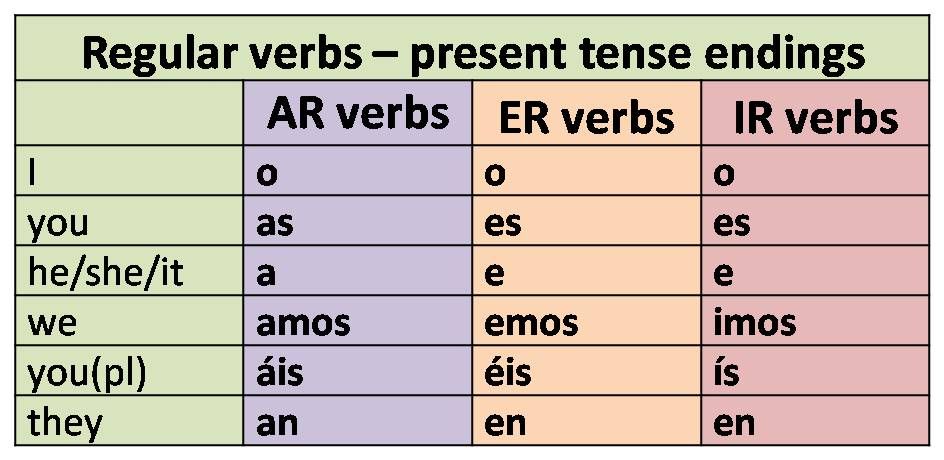While vocabulary holds the key of making you understand what one said and communicating with others, grammar is also important as it lays the groundwork for effective communication. Failing to learn grammar may cause communication breakdown. Today's grammar topic is Spanish present simple tense. Let's find out when should you use the present simple tense, what are forms of present tense and how to conjugate verbs in Spanish.
Simple present tense usage – When should you use simple present tense in Spanish?
Like in English, Spanish present simple tense (el presente/el presente del indicativo) is used to talk about habits, routines, universal truth, facts, short actions that are happening now, hypothetical situations, or a timetable or a fixed plan.
For xamples:
Me levanto a las seis y media cada mañana - I get up at six thirty every morning.
Estudio biología en la universidad - I study biology at the university.
Uno más uno son dos - One plus one is two.
Si llega Marcos, salgo - If Marcos comes, I'm out.
How to conjugate verbs in Spanish simple present tense
1. REGULAR VERBS
Regular verbs in Spanish only change their ending part depending on who does the action.
Check out to see gender rules in Spanish nouns
There are three main categories when it comes to the endings of the verb:
- Those that end in -AR
- Verbs that end in -ER
- Verbs ending in -IR
In order to make the present tense in Spanish you must use the root (stem) of the word and then add on the appropriate ending, according to the subject and verb type (-AR/-ER/-IR).

Present tense in Spanish - Regular verb endings
-AR verb conjugation
To conjugate an -ar verb, you just need to remove the infinitive ending -ar then add the ending that matches the subject.
Examples for the word “Hablar”
Subject | -ar endings | Hablar |
yo (I) | -o | hablo |
tú (you) (informal) | -as | hablas |
usted (you) (formal) | -a | habla |
él, ella (he/she) | -a | habla |
nosotros (we) | -amos | hablamos |
vosotros (you) (informal) | -áis | habáis |
ustedes, ellos, ellas (you) (formal | -an | hablan |
ellos, ellas (they) | -an | hablan |
-ER verb conjugation
Examples for "comer"
Subject | -er endings | Comer |
yo (I) | -o | como |
tú (you) (informal) | -es | comes |
usted (you) (formal) | -e | come |
él, ella (he/she) | -e | come |
nosotros (we) | -emos | comemos |
vosotros (you) (informal) | -éis | coméis |
ustedes, ellos, ellas (you) (formal | -en | comen |
ellos, ellas (they) | -en | comen |
-IR verb conjugation
Examples for "vivir"
Subject | -ir endings | Vivir |
yo (I) | -o | vivo |
tú (you) (informal) | -es | vives |
usted (you) (formal) | -e | vive |
él, ella (he/she) | -e | vive |
nosotros (we) | -imos | vivimos |
vosotros (you) (informal) | -is | vivis |
ustedes, ellos, ellas (you) (formal | -en | viven |
ellos, ellas (they) | -en | viven |
2. IRREGULAR VERBS
How about verbs that don't end in -ar, -ir, or -er? What rule would they follow?
Some verbs that end in -guir, -ger, -gir changes their spelling in the present simple tense.
- Verbs that end in -guir changes to -go
- Verbs that end in -ger and -gir changes to -jo
Examples:
extinguir (extinguish) - extingo
dirigir (direct) - dirijo
recoger (pick up) - recojo
There are still verbs that don't follow any rule:
- caber (fit) -quepo
- caer (fall) - caigo
- conocer (know) - conozco
- dar (give) - doy
- hacer (do/make) - hago
- poner (put) - pongo
- saber (know) - sé
- salir - (leave/go out) - salgo
- traducir (translate) - traduzco
- traer (bring ) - traigo
- valer (to be worth ) - valgo
- ver (see) - veo
Follow our site for daily grammar and vocabulary lessons!
